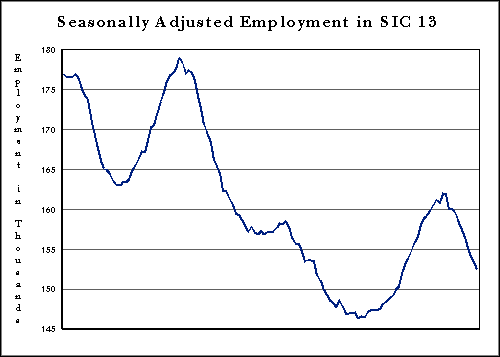This current state of affairs was precipitated by events largely external to Texas, as North Sea oil producers stepped up their output along with others in South America, Africa, and to a lesser extent, the Middle East. This, combined with the less-than-normal demand for home heating oil across North America during the fall and winter of 1998-1999, has led to far-reaching effects here in Texas. Finally, several mergers of some of the world’s largest oil companies have resulted in consolidations, which potentially will cause more layoffs.

The oil and gas industry, Standard Industrial Classification (SIC) 13, includes both the exploration for, and extraction of, oil and natural gas, the production of oil and gas from various sources up to the point of shipment, and oil and gas field services. Employment in the Texas oil and gas industry hit its heyday in January 1982 with a peak of 313,700 jobs out of 6,271,400 total Nonagricultural Wage and Salary jobs statewide. This represented fully 5.0 percent of the total Texas labor market. Ensuing worldwide competition in oil production and increased efficiencies in exploration and drilling techniques have subsequently caused a significant drop in Texas oil and gas industry employment since that period. In fact, in January 1999, employment had fallen by more than half to 152,300 jobs while Total Nonagricultural Wage and Salary Employment grew by more than 2.7 million jobs to a total of 8,988,200. Today, the oil and gas industry accounts for only 1.7 percent of the total. One of the principal indicators of the health of the oil and gas industry along with employment is the oil and gas drilling rig count. Understandably, the rig count closely mirrored employment in the oil and gas industry, peaking in 1981 at nearly 1,450 rigs in service. That figure fell to as little as 380 in March 1998 (its high point for the year) and now stands at a paltry 199, a 47.6 percent drop in eleven months. Oil and gas losses in some West Texas counties have been severe recently, affecting not just the level of employment, but adversely impacting property appraisals as well. The loss of tax revenues has a domino effect on the local community, which will constrain local government budgets including numerous independent school districts. These effects are often most prominent in counties which have a less-diversified economy and which have small or medium-sized populations.
The sudden upturn in unemployment is now having a detrimental impact on local communities. This includes not only the obvious effects of idled rigs, businesses cutting back, and people being laid off and filing claims for unemployment insurance benefits or public assistance, but other not-so-obvious consequences. As previously mentioned, local tax revenues in parts of the state are being severely affected by this downturn. Several independent school districts in West Texas are estimating their losses upwards of $5,000,000. In addition, some rural hospitals supported by county budgets are being hard hit by the reduction in revenue, and will have to consider alternative funding or cutbacks. Likewise, some city and county governments will have to trim budgets, and perhaps services, to account for the expected loss in revenue. Finally, many private individuals in Texas will suffer losses of revenue from oil leases and royalties.
Is there room for optimism? According to the Energy Information Administration, a slight rise in oil prices from their historically low levels is anticipated. Domestic producers have stated they need at least $12 to $15 per barrel to break even and considerably above that to begin new drilling. Aided by increased demand from recovering Asian markets and from other emerging economies, the world price for crude oil is expected to rise to $14.25 per barrel by the year 2000. Some state revenue estimators have echoed that forecast, predicting that prices could increase by as much as 25 percent by the end of the year. Beyond the millennium, economists are predicting gradual but steady growth in world demand. Along with increased demand though, will come an increase in the world supply as North Sea producers, some South American countries, and offshore production near Africa and Asia will all contribute added output. In short, if world demand grows faster than world supply, the Texas oil and gas industry can presumably hold its own, but any recovery from our current position will likely occur over a matter of years and not months.
* Reprinted with permission from the February 1999 issue of The Texas Labor Market Review, a monthly publication produced by the Labor Market Information Department of the Texas Workforce Commission (http://www.twc.state.tx.us/).